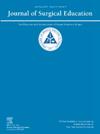Nonmusicians With High Music Perception: A Distinct Category in Visuospatial and Surgical Skill Assessment
IF 2.6
3区 医学
Q1 EDUCATION, SCIENTIFIC DISCIPLINES
引用次数: 0
Abstract
BACKGROUND
Musicians tend to outperform nonmusicians in spatial tasks and surgical skills, but an unexplored group is nonmusicians with high music perception - musical sleepers.
METHODS
In this cross-sectional study of 150 female right-handed first-year medical students, after segregating musicians (M), we identified musical sleepers (S) as nonmusicians who scored more than the sample median in the Mini Profile of Music Perception (MiniPROMS). The rest were classified as nonmusicians with low music perception (N). The performance of the mental rotation (MR) task (n = 150) and surgery knotting task (SP) (n = 49) was evaluated. A correlation analysis was conducted between MR and MP scores (n = 150), and a partial correlation analysis was done for MP and SP (n = 56) while controlling for MR.
RESULTS
M (p < 0.001) and S (p = 0.021) outperformed N in the MRT, but no significant difference existed between S and M. In the SP, there was no difference between S and N. Lastly, MP and MR showed a weak correlation, and after controlling for MR, MP modestly correlated with SP scores (r = 0.268, p = 0.048).
CONCLUSION
Musical sleepers demonstrate better spatial task performance than nonmusicians, although no clear benefit was seen in surgical tasks. Future research is needed to determine if these advantages extend to surgical performance.
具有高音乐感知的非音乐家:视觉空间和外科技能评估中的一个独特类别
音乐家往往在空间任务和外科手术技能上胜过非音乐家,但一个未被探索的群体是具有高音乐感知的非音乐家-音乐睡眠者。方法在这项对150名女性右撇子医科一年级学生的横断面研究中,在将音乐家(M)分开后,我们将音乐睡眠者(S)确定为非音乐家,他们在音乐感知迷你档案(MiniPROMS)中的得分高于样本中位数。其余被分类为低音乐感知的非音乐家(N)。评估心理旋转(MR)任务(N = 150)和手术打结任务(N = 49)的表现。先生和议员之间进行了相关分析分数(n = 150)和偏相关分析是议员和SP (n = 56),而控制MR.RESULTSM (p & lt; 0.001)和S (p = 0.021)优于n在捷运,但没有显著差异存在S和m . SP,之间没有区别和n .最后,议员和奥呈弱相关,适度控制先生之后,国会议员与SP分数(r = 0.268,p = 0.048)。结论音乐睡眠者比非音乐睡眠者表现出更好的空间任务表现,尽管在外科任务中没有明显的优势。未来的研究需要确定这些优势是否延伸到手术表现。
本文章由计算机程序翻译,如有差异,请以英文原文为准。
求助全文
约1分钟内获得全文
求助全文
来源期刊

Journal of Surgical Education
EDUCATION, SCIENTIFIC DISCIPLINES-SURGERY
CiteScore
5.60
自引率
10.30%
发文量
261
审稿时长
48 days
期刊介绍:
The Journal of Surgical Education (JSE) is dedicated to advancing the field of surgical education through original research. The journal publishes research articles in all surgical disciplines on topics relative to the education of surgical students, residents, and fellows, as well as practicing surgeons. Our readers look to JSE for timely, innovative research findings from the international surgical education community. As the official journal of the Association of Program Directors in Surgery (APDS), JSE publishes the proceedings of the annual APDS meeting held during Surgery Education Week.
 求助内容:
求助内容: 应助结果提醒方式:
应助结果提醒方式:


